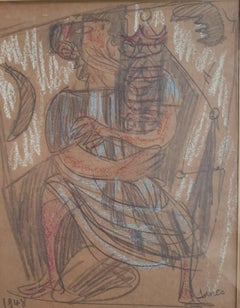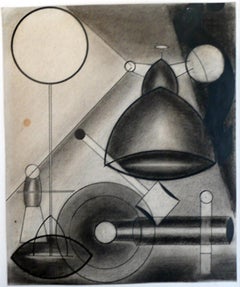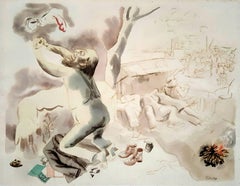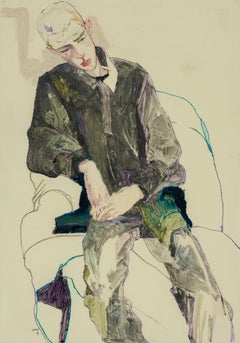Dada Drawings and Watercolor Paintings
to
4
1
3
4
2
3
2
1
Overall Height
to
Overall Width
to
7,289
6,343
5,404
2,124
611
523
493
456
383
323
223
198
76
74
5
4
3
2
2
1
1
5
1
3
2
3
2
1
5
5
4
2
1
Style: Dada
No title
By Marcel Janco
Located in Tel Aviv - Jaffa, IL
Original ink on paper
Hand signed lower right
Unique piece
Category
1940s Dada Drawings and Watercolor Paintings
Materials
Ink
Dancing Hassid
By Marcel Janco
Located in Tel Aviv - Jaffa, IL
Original mixed media on paper
Combining pastel, watercolor and pencil
Hand signed and dated lower right
Unique piece
Category
1940s Dada Drawings and Watercolor Paintings
Materials
Oil Pastel, Watercolor, Pencil
Composition in charcoal of a light with objects and a football Kurt Schwitters
By Thijs Rinsema
Located in Brookville, NY
Working with Kurt Schwitters from the Dada school of art this composition of a light with various objects and a football done in charcoal is a wonderfu...
Category
1930s Dada Drawings and Watercolor Paintings
Materials
Charcoal
Christus am Oelberg - Christ on the Mount of Olives
By George Grosz
Located in Miami, FL
This work is accompanied by a Photo-certificate and essay from Ralph Jentsch who will include it in his forthcoming catalogue raisonné
Signed lower right.
Estate stamp on verso...
Category
1930s Dada Drawings and Watercolor Paintings
Materials
Ink, Watercolor
Christus am Oelberg - Christ on the Mount of Olives
By George Grosz
Located in Miami, FL
This work is accompanied by a Photo-certificate and essay from Ralph Jentsch who will include it in his forthcoming catalogue raisonné
Signed lower right.
Estate stamp on ...
Category
1930s Dada Drawings and Watercolor Paintings
Materials
Ink, Watercolor
Reclining Nude
By Marcel Janco
Located in London, GB
MARCEL JANCO 1895-1984
Bucarest 1895-1984 Ein Hod (Rumanian/Israeli)
Title: Reclining Nude
Technique: Original signed Watercolour and Ink on paper
s...
Category
Dada Drawings and Watercolor Paintings
Materials
Ink, Paper, Watercolor
Madonna and Child
Located in Kansas City, MO
Artist : Jolynn Reigeluth
Title : Madonna and Child
Materials : India ink, graphite, collage and acrylic
Date : 2017
Dimensions : 55" x 39" in.
Jolynn Reigeluth is an artist and fre...
Category
2010s Dada Drawings and Watercolor Paintings
Materials
India Ink, Acrylic, Graphite
Related Items
The Abduction of the Sabine Women , a Renaissance drawing by Biagio Pupini
Located in PARIS, FR
This vigorous drawing has long been attributed to Polidoro da Caravaggio: The Abduction of the Sabine Women is one of the scenes that Polidoro depicted between 1525 and 1527 on the façade of the Milesi Palazzo in Rome. However, the proximity to another drawing inspired by this same façade, kept at the Ecole des Beaux-Arts, and to other drawings inspired by Polidoro kept at the Musée du Louvre, leads us to propose an attribution to Biagio Pupini, a Bolognese artist whose life remains barely known, despite the abundant number of drawings attributed to him.
1. Biagio Pupini, a Bolognese artist in the light of the Roman Renaissance
The early life of Biagio Pupini, an important figure of the first half of the Cinquecento in Bologna - Vasari mentions him several times - is still poorly known. Neither his date of birth (probably around 1490-1495) nor his training are known. He is said to have been a pupil of Francesco Francia (1450 - 1517) and his name appears for the first time in 1511 in a contract with the painter Bagnacavallo (c. 1484 - 1542) for the frescoes of a church in Faenza. He then collaborated with Girolamo da Carpi, at San Michele in Bosco and at the villa of Belriguardo.
He must have gone to Rome for the first time with Bagnacavallo between 1511 and 1519. There he discovered the art of Raphael, with whom he might have worked, and that of Polidoro da Caravaggio. This first visit, and those that followed, were the occasion for an intense study of ancient and modern art, as illustrated by his abundant graphic production.
Polidoro da Caravaggio had a particular influence on the technique adopted by Pupini. Executed on coloured paper, his drawings generally combine pen, brown ink and wash with abundant highlights of white gouache, as in the drawing presented here.
2. The Abduction of the Sabine Women
Our drawing is an adaptation of a fresco painted between 1525 and 1527 by Polidoro da Caravaggio on the façade of the Milesi Palace in Rome. These painted façades were very famous from the moment they were painted and inspired many artists during their stay in Rome. These frescoes are now very deteriorated and difficult to see, as the palace is in a rather narrow street.
The episode of the abduction of the Sabine women (which appears in the centre of the photo above) is a historical theme that goes back to the origins of Rome and is recounted both by Titus Livius (Ab Urbe condita I,13), by Ovid (Fasti III, 199-228) and by Plutarch (II, Romulus 14-19). After killing his twin brother Romus, Romulus populates the city of Rome by opening it up to refugees and brigands and finds himself with an excess of men. Because of their reputation, none of the inhabitants of the neighbouring cities want to give them their daughters in marriage. The Romans then decide to invite their Sabine neighbours to a great feast during which they slaughter the Sabines and kidnap their daughters.
The engraving made by Giovanni Battista Gallestruzzi (1618 - 1677) around 1656-1658 gives us a good understanding of the Polidoro fresco, allowing us to see how Biagio Pupini reworked the scene to extract this dynamic group.
With a remarkable economy of means, Biagio Pupini takes over the left-hand side of the fresco and depicts in a very dense space two main groups, each consisting of a Roman and a Sabine, completed by a group of three soldiers in the background (which seems to differ quite significantly from Polidoro's composition).
The balance of the drawing is based on a very strongly structured composition. The drawing is organised around a median vertical axis, which runs along both the elbow of the kidnapped Sabine on the left and the foot of her captor, and the two main diagonals, reinforced by four secondary diagonals. This diamond-shaped structure creates an extremely dynamic space, in which centripetal movements (the legs of the Sabine on the right, the arm of the soldier on the back at the top right) and centrifugal movements (the arm of the kidnapper on the left and the legs of the Sabine he is carrying away, the arm of the Sabine on the right) oppose each other, giving the drawing the appearance of a whirlpool around a central point of support situated slightly to the left of the navel of the kidnapper on the right.
3. Polidoro da Caravaggio, and the decorations of Roman palaces
Polidoro da Caravaggio was a paradoxical artist who entered Raphael's (1483 - 1520) workshop at a very young age, when he oversaw the Lodges in the Vatican. Most of his Roman work, which was the peak of his career, has disappeared, as he specialised in facade painting, and yet these paintings, which are eminently visible in urban spaces, have influenced generations of artists who copied them abundantly during their visits to Rome.
Polidoro Caldara was born in Caravaggio around 1495-1500 (the birthplace of Michelangelo Merisi, known as Caravaggio, who was born there in 1571), some forty kilometres east of Milan. According to Vasari, he arrived as a mason on the Vatican's construction site and joined Raphael's workshop around 1517 (at the age of eighteen according to Vasari). This integration would have allowed Polidoro to work not only on the frescoes of the Lodges, but also on some of the frescoes of the Chambers, as well as on the flat of Cardinal Bibiena in the Vatican.
After Raphael's death in 1520, Polidoro worked first with Perin del Vaga before joining forces with Maturino of Florence (1490 - 1528), whom he had also known in Raphael's workshop. Together they specialised in the painting of palace façades. They were to produce some forty façades decorated with grisaille paintings imitating antique bas-reliefs.
The Sack of Rome in 1527, during which his friend Maturino was killed, led Polidoro to flee first to Naples (where he had already stayed in 1523), then to Messina. It was while he was preparing his return to the peninsula that he was murdered by one of his assistants, Tonno Calabrese, in 1543.
In his Vite, Vasari celebrated Polidoro as the greatest façade decorator of his time, noting that "there is no flat, palace, garden or villa in Rome that does not contain a work by Polidoro". Polidoro's facade decorations, most of which have disappeared as they were displayed in the open air, constitute the most important lost chapter of Roman art of the Cinquecento. The few surviving drawings of the painter can, however, give an idea of the original appearance of his murals and show that he was an artist of remarkable and highly original genius.
4. The façade of the Milesi Palace
Giovanni Antonio Milesi, who commissioned this palace, located not far from the Tiber, north of Piazza Navona, was a native of the Bergamo area, like Polidoro, with whom he maintained close friendly ties. Executed in the last years before the Sack of Rome, around 1526-1527, the decoration of Palazzo Milesi is considered Polidoro's greatest decorative success.
An engraving by Ernesto Maccari made at the end of the nineteenth century allows us to understand the general balance of this façade, which was still well preserved at the time. The frescoes were not entirely monochrome, but alternated elements in chiaroscuro simulating marble bas-reliefs and those in ochre simulating bronze and gold vases...
Category
16th Century Dada Drawings and Watercolor Paintings
Materials
Ink, Gouache, Pen
Lee Hurst (3/4 Figure, Hands Together), Mixed media on Pergamenata parchment
Located in London, GB
Howard Tangye (b.1948, Australia) has been an influential force in fashion for decades. Lecturing at London’s Central Saint Martins for 35 years, including 16 years as head of BA Wom...
Category
2010s Dada Drawings and Watercolor Paintings
Materials
Paint, Paper, Parchment Paper, Charcoal, Crayon, Oil Crayon, Oil Pastel,...
Fall to Grace
Located in Philadelphia, PA
"Fall to Grace" is an original ink and watercolor painting on paper mounted to wood by artist Robert Kraiza measuring 19in height x 9in width.
Artist Statement // In my work I invoke a whimsical world inspired by Victorian and Edwardian eras. To me they represent a romantic time period that has roots that extend directly into the modern world, both good and bad. The customs and aesthetics of the period are both fascinating and breathtaking but a vast portion of the population was victim to subjugation. It has since been eradicated on paper but still permeates to this day. I am exploring an imagined supernatural world hidden just out of sight where these woman could escape. This is an evolution from my earlier work set in the same time period with a continuous thread of humans and their animal companions.
Through witchcraft these women find strength in their abilities and each other to leave the oppressive world they inhabit behind and escape to the woods to their Covendom, the boundary that defines the territory of their coven. They shed their customs, their corsets, and their concerns at the edge of the forest and gather among the trees to explore their magical potential with their familiars at the side.
This body of work is exploring multiple media with a consistent theme and setting; combining watercolor painting, pen and ink illustrations, and graphite drawings. All pieces are created in monochrome on hot press watercolor paper mounted on wood with a gold painted border reminiscent of daguerreotype frames. Watercolor allows me to achieve results ranging from soft ethereal layered washes similar to oil glazes to precise minute details I include in all of my works.
Bio // ROBERT KRAIZA (pronounced: cry-zuh) is an illustrator and fine artist who lives and works in Philadelphia, Pennsylvania. He studied Media Arts and Animation at the Art Institute of Philadelphia. Interested in many media, he often paints in monochrome watercolor on a small scale, inspired by the Victorian era and whimsical dreams in both his art and personal aesthetic. Depicting fantasy worlds from the hidden life of nineteenth century witches to miniature children...
Category
21st Century and Contemporary Dada Drawings and Watercolor Paintings
Materials
Ink, Watercolor, Archival Paper
Original French Art Deco Gouache Illustration Drawing by J. Hilly
Located in Atlanta, GA
An original Art Deco illustration hand-painted with ink and gouache on paper. The drawing features two elegant women with large windows and drapery in the background. This illustrati...
Category
1930s Dada Drawings and Watercolor Paintings
Materials
Paper, Ink, Gouache
H 15.56 in W 12.01 in D 1.97 in
Freya (Seated Backwards), Mixed media on grey board
Located in London, GB
Howard Tangye (b.1948, Australia) has been an influential force in fashion for decades. Lecturing at London’s Central Saint Martins for 35 years, including 16 years as head of BA Wom...
Category
2010s Dada Drawings and Watercolor Paintings
Materials
Other Medium, Archival Paper, Handmade Paper, Pen, Felt Pen, Permanent M...
Gustav Melcher ( German, 1898 -?) Boats off Venice Italy Ink Water Color c. 1918
By Gustav Melcher
Located in Meinisberg, CH
Gustav Melcher
(German, 1898-?)
Segelschiffe vor Venedig - Sailing ships off Venice
• India ink, water colour wash
• Visible image ca. 11.5 x 18 cm
• Glased Frame ca. 20 x 25 cm
• Verso various inscriptions
• Signed lower right
Gustav Melcher was a German painter and a pioneer in film, film criticism and film theory and created this clever little picture of the skyline of Venice with various vessels.
Going by the various inscriptions an the backing paper, this drawing was made in 1918 when Gustav was twenty years old and passed on three years later to Gertrud Melcher on the 1. 2. 1921. I have no reasons to doubt this information. The small drawing is still in its unopened frame, so maybe there is more information to be discovered , however this will be the privilege of the next owner.
The picture also has retained its original antique frame – note that it has lost over the years various sections of the gesso decoration.
The very precisely executed drawing is most enjoyable to look at and doing so, remember you are looking through the eyes of a young man, who saw this foreign sea cape over a century ago.
Thank you for your interest and please note, that I offer free worldwide shipping on all my items.
Gustav Melcher began his studies at the Düsseldorfer Kunstakademie under Peter Janssen and Eduard von Gebhardt. Originaly he was interested in figurative and portrait painting, but after time he decided to pursue the depiction of land- and marinescapes. Durin his studies the young artist undertook trips to visit England, Scotland, Belgium and France and he joined the artist society Malkasten. It was in those days he would hold speeches to his colleges about this new invention called ‘Kintopp’ – Melcher was a great advocate of the moving pictures...
Category
1910s Dada Drawings and Watercolor Paintings
Materials
India Ink, Paper, Watercolor
Gustav MelcherGustav Melcher ( German, 1898 -?) Boats off Venice Italy Ink Water Color c. 1918, 1918
Free Shipping
H 7.88 in W 9.85 in D 0.79 in
Mughal School, 18th century – Emperor Jahangir in his harem in flagrante delicto
Located in Middletown, NY
An illuminated page from a book likely in reference to palace life during Emperor Jahangir's reign over the Mughal Empire.
Circa 1750. Gouache and ink with gold heightening on cre...
Category
18th Century Dada Drawings and Watercolor Paintings
Materials
Gold
Mughal School, 18th century – Emperor Jahangir dancing with his harem attendees
Located in Middletown, NY
A joyful scene of lighthearted merriment in the palace of Jangahir Mahal Agra
Circa 1750. Gouache and ink with gold heightening on light weight cream laid paper, 8 1/4 x 6 inches (2...
Category
18th Century Dada Drawings and Watercolor Paintings
Materials
Gold
Study with Torso, Hands, and Umbrella - The characteristic of the inconspicuous
Located in Berlin, DE
Paul Friedrich Meyerheim (1842 Berlin - 1915 ibid.). Sketch of a female torso with hands and an umbrella. Pencil on paper, 27.5 x 22.5 cm (visible size)...
Category
1890s Dada Drawings and Watercolor Paintings
Materials
Pencil
H 11.03 in W 9.06 in D 0.4 in
Akt mit Strümpfen
Located in Wien, 9
August Dressler is one of the painters of the New Objectivity. He is one of the lesser-known artists of the Weimar era, but he too, like his famous contemporaries Georg Grosz, John H...
Category
1920s Dada Drawings and Watercolor Paintings
Materials
Watercolor, Ink
Bayus
By Nicholas Conrad Miller
Located in Buffalo, NY
An original mixed media work by Contemporary American artist Nicholas Conrad Miller.
Category
21st Century and Contemporary Dada Drawings and Watercolor Paintings
Materials
Archival Ink, Gouache, Watercolor
Oleg (Kimono), Mixed media on ochre parchment paper
Located in London, GB
Howard Tangye (b.1948, Australia) has been an influential force in fashion for decades. Lecturing at London’s Central Saint Martins for 35 years, including 16 years as head of BA Wom...
Category
2010s Dada Drawings and Watercolor Paintings
Materials
Paint, Paper, Parchment Paper, Charcoal, Crayon, Oil Crayon, Oil Pastel,...
Dada drawings and watercolor paintings for sale on 1stDibs.
Find a wide variety of authentic Dada drawings and watercolor paintings available for sale on 1stDibs. Works in this style were very popular during the 21st Century and Contemporary, but contemporary artists have continued to produce works inspired by this movement. Many Pop art paintings were created by popular artists on 1stDibs, including Marcel Janco, George Grosz, and Jolynn Reigeluth. Frequently made by artists working with Ink, and Paint and other materials, all of these pieces for sale are unique and have attracted attention over the years. Not every interior allows for large Dada drawings and watercolor paintings, so small editions measuring 5.91 inches across are also available. Prices for drawings and watercolor paintings made by famous or emerging artists can differ depending on medium, time period and other attributes. On 1stDibs, the price for these items starts at $750 and tops out at $37,000, while the average work sells for $3,000.
Recently Viewed
View AllMore Ways To Browse
Japanese Watercolor Panel
Bath Poster
Palm Tree Watercolor
Dior Top Mens
Gay Vintage Drawings
Thousand Of Nights
Basquiat Green
Russian Interior Watercolors
New Zealand Watercolor
Santa Fe Chairs
Bennett Tom
Antique Watercolour Box
Antique Watercolour Boxes
Antique Watercolor Boxes
Antique Watercolor Box
Antique Watercolour Box Boxes
Antique Watercolor Box Boxes
Joan Miro Watercolor







